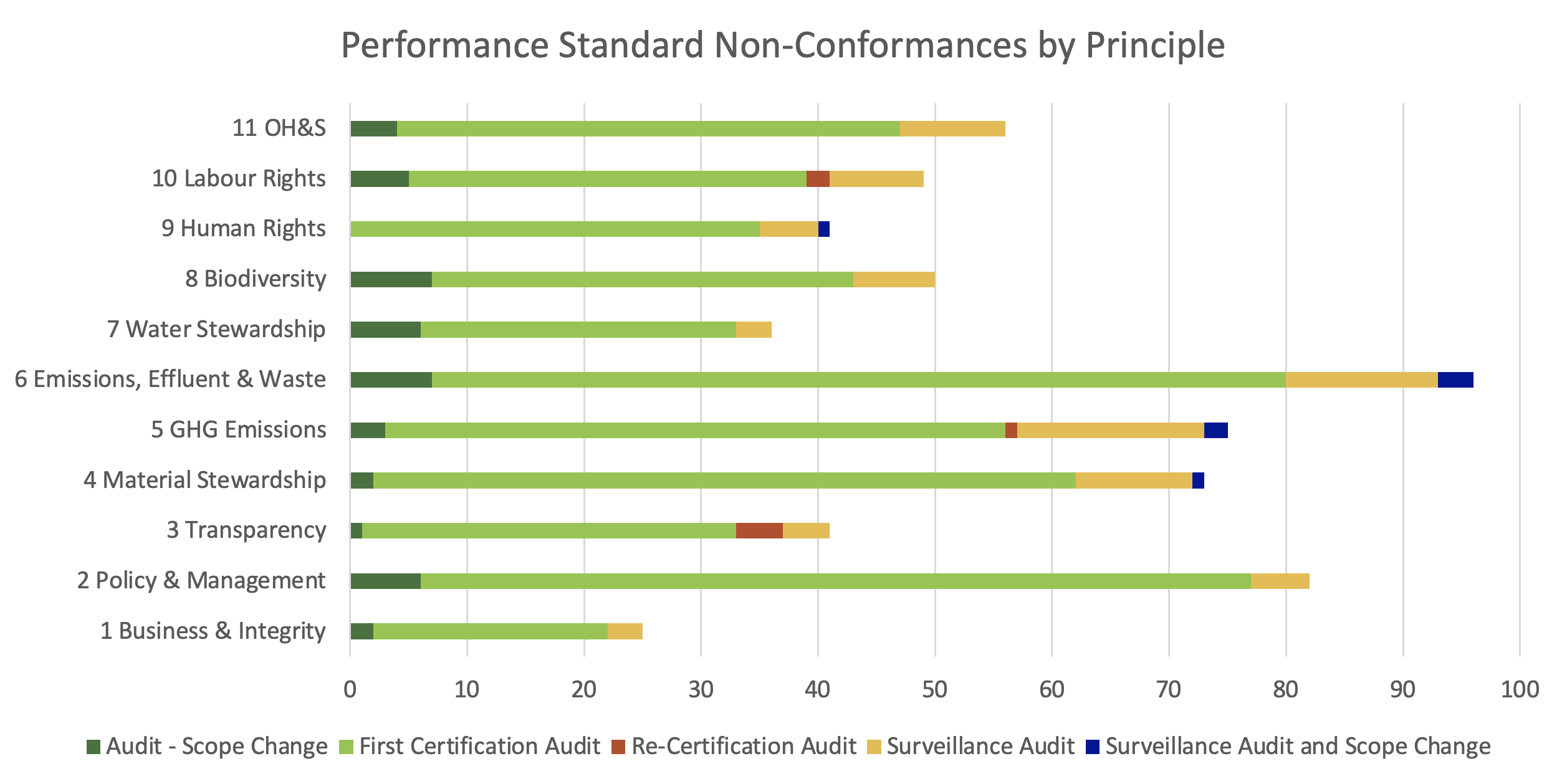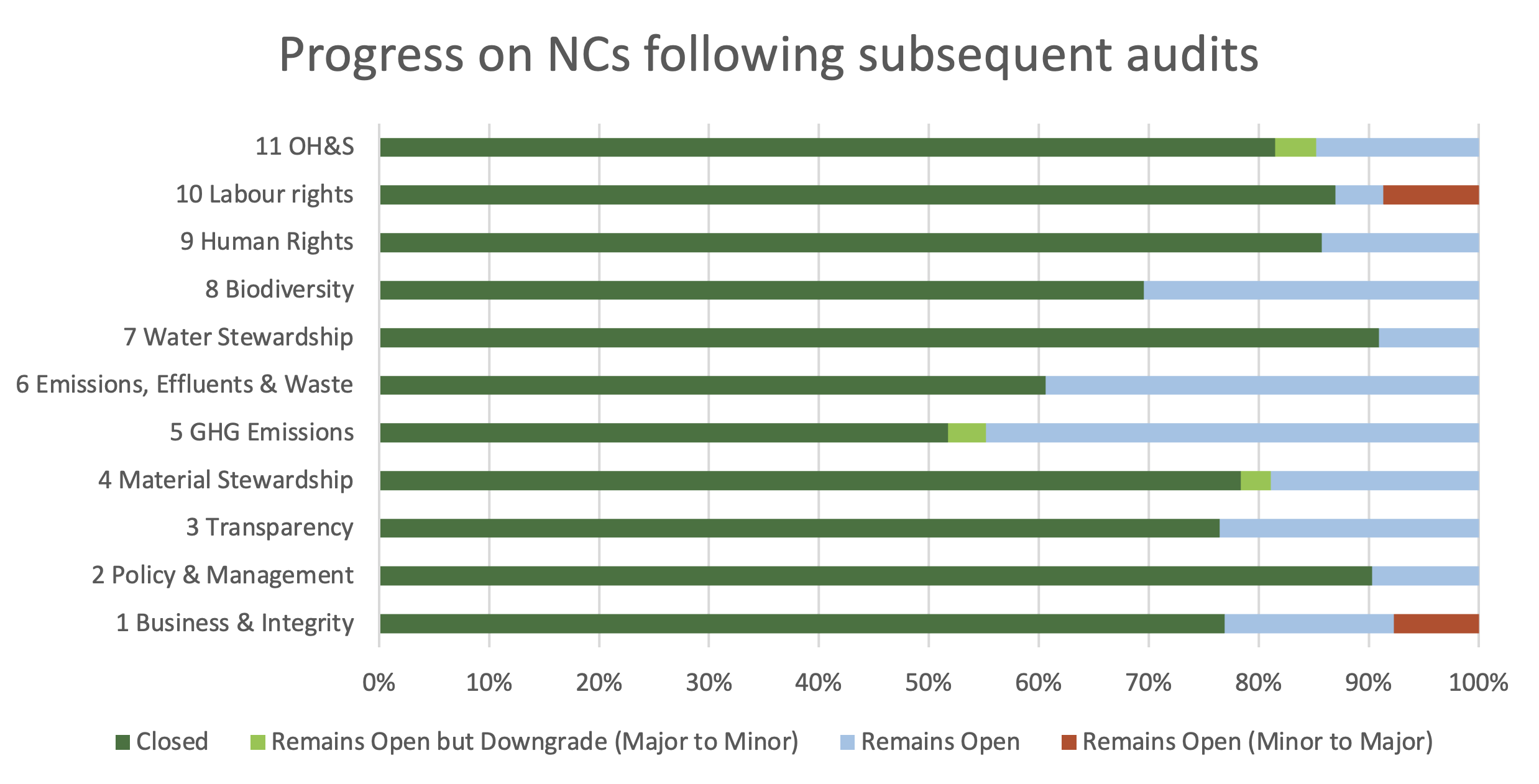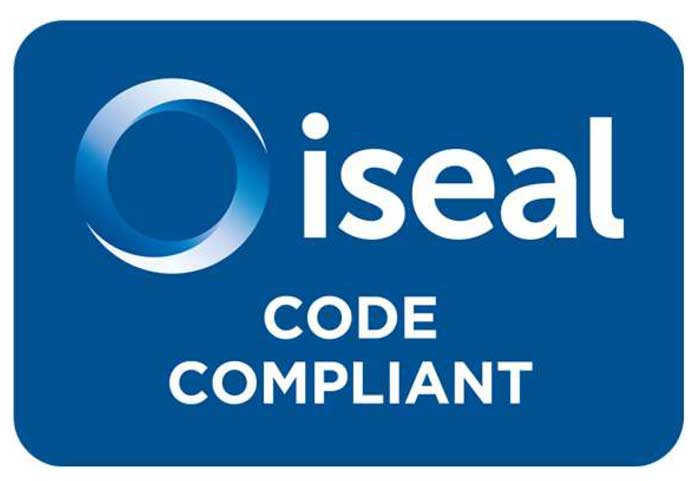D&R Insights: Latest ASI Non-Conformance data
ASI Certified Entities are closing Non-Conformances (NCs) under the ongoing assurance program, demonstrating Performance Standard Certification is a driver for change. 75% of NCs are closed within 12-18 months, while NCs relating to GHG emissions and waste management are taking longer.
26 September 2022
The latest analysis of Non-Conformances (NCs) found during ASI Performance Standard (V2, 2017) audits, undertaken between January 2018 (program launch) and June 2022, has identified some key findings, such as:
- Principle 6 Emissions – Effluents & Waste, Principle 2 – Policy & Management, and Principle 5 – GHG Emissions yielded the highest number of both Major and Minor NCs across all Entities.
- Major Non-Conformances (resulting in Provisional Certification only being awarded) were identified for 9 Entities, mainly under Principle 8 Biodiversity, Principle 1 Business Integrity, Principle 2 Policy & Management, Principle 4 Material Stewardship, Principle 10 Labour Rights, and Principle 11 Occupational Health & Safety.
- Certified Entities with NCs improve their performance before subsequent (surveillance) audits: more than 75% of Non-Conformances were addressed within 12-18 months, with the highest proportion under Principle 7 Water Stewardship (91% of a total 11 NCs closed), Principle 2 Policy & Management (90% of 31 NCs closed), and Principle 10 Labour Rights (87% of 23 NCs closed).
The analysis, which also explores the corrective actions Entities undertake in response to audit NCs, also found that:
- Reductions of GHG Emissions and Spent Pot Lining were among issues requiring more time to implement Corrective Action Plans and close raised Non-Conformances.
- Six out of nine Entities with Major Non-Conformances/Provisional Certification adequately addressed the identified issues through a Corrective Action Plans and transitioned towards Full Certification. Currently, 3 Entities hold Provisional Certifications with subsequent audits still to occur. To date, Provisional Certification is serving as a pathway to performance improvement.
- For 16 Entities, Re-Certification Audits and Surveillance Audits yielded new NCs; analysis of audit report data indicates that none of these were due to scope change, but rather newly identified issues. Further analysis should be conducted in this regard (e.g., audit consistency, specific availability of objective evidence etc), and Re-Certification Audit NCs are expected to occur more frequently as Entities transition to the new (V3, 2022) Performance Standard.
Non-conformances are a traceable metric for measuring change among certifying Entities. Unlike efforts that organisations may make pre-certification in order to meet standards, the closure of auditor-identified non-conformances are an independently demonstrated improvement outcome. In aggregate and over time, these metrics help show the impact of ASI Standards implementation on Entities’ individual and collective performance.

This figure presents an overview of all Non-Conformances under ASI Performance Standard broken down by Principle and Audit Type during which the Non-Conformance was recorded.
The common grounds for Non-Conformances for the top three Principles of NC occurrence are as follows:
Principle 6 Emissions, Effluents and Waste
Almost all Entities publicly disclose information on waste management, however:
- Reporting is not detailed enough especially regarding distinction between hazardous and non-hazardous waste generation and associated methods of disposal.
- Waste management strategy not designed in accordance with the Waste Mitigation Hierarchy or requires improvement in controls of waste storage to prevent any potential future impacts to the environment and human health.
Principle 2 Policy and Management
Entities develop policies, systems, procedures and processes around responsible sourcing (except very few instances where the Responsible Sourcing Policy has not been formally established or incorporated into Entity’s current policy framework), however:
- Implementation of those is ineffective:
- Supplier and service provider screening is not maintained in accordance with Responsible Sourcing Policies and Procurement Policies;
- Responsible Sourcing Policies are not communicated to all suppliers;
- Some social responsibility aspects are not covered in Procurement Policies.
Principle 5 GHG Emissions
Monitoring and public disclosure of energy use and GHG Emissions has become a new normal. As shown in the Analysis of Implementation of Greenhouse Gas (GHG) Emissions Reporting from ASI Certified Entities: March 2020 – March 2021 Update the overall level and data quality of disclosed data for various ASI Entities has improved compared to the 2020 review, however:
- Some information is still missing (e.g. energy by source), methodology for calculations is not clearly defined and reported data is not verified by a 3rd party leading to poor data accuracy and inability to benchmark across the industry.
Entities develop GHG emissions reduction plans, however:
- Plans are still not as comprehensive as they should be and are missing time-bound targets.
Major Non-Conformances were mainly identified under Principle 8 Biodiversity, Principle 4 Material Stewardship, and Principle 11 Occupational Health & Safety resulting in Provisional Certifications for 9 Entities.
Entities which have Major Non-Conformances (maximum allowed – 3) were issued Provisional Certifications of one year to encourage improvement and target transition towards Conformance within two consecutive years. All Entities for which a subsequent audit has occurred adequately addressed identified issues through a Corrective Action Plan and transitioned towards Full Certification. In three instances Major Non-Conformances were downgraded and remain open as Minor Non-Conformances and relate to GHG emissions reductions, engagement in collection and recycling of products at end-of-life, and OH&S Management Systems. One Major Non-Conformance (OH&S Management Systems) was not addressed during the first surveillance audit, and is to be closed in the next one. Currently, 3 Entities hold Provisional Certifications as their subsequent audits have not occurred yet.
Certified Entities improve their performance: more than 75% of Non-Conformances have been addressed during subsequent audits within 12-18 months, with the highest proportion of NCs closed under Principle 7 Water Stewardship, Principle 2 Policy & Management, and Principle 10 Labour Rights.
Out of all closed Non-Conformances, 98% were addressed during a surveillance audit with just a few during re-certification.
Examples of Non-Conformances and Corrective Action Plans for the top three Principles for NC closure are listed below:
Principle 7 Water Stewardship
- Lack of water management plans with time-bound targets
- Water risk assessment does not refer to impacts from water suppliers and water disposal contractors
- Lack of disclosure of water usage and risks
Corrective Actions:
- Development and implementation of Water Management Plan including employees training
- Public disclosure of water usage including targets and material risks
- Inclusion of missing elements in water risk assessment
Principle 2 Policy and Management
- Policies were not communicated to all stakeholders
- Social Management Systems were not documented and/or reviewed
- Responsible Sourcing Policy was not developed or abided.
Corrective Actions:
- Policies communicated with employees and with external stakeholders as well
- Missing elements in the Social Management Systems reviewed and defined including aspects on cultural, human rights and gender issues.
Principle 10 Labour Rights
- Not all workers received a living wage
- Not all workers enrolled in mandatory social insurance scheme
- Incidences where overtime and period of rest for few workers were not in line with legal requirements
- Untimely payments of salaries or missing all documentation
Corrective Actions:
- Collective Bargaining Agreement signed
- All workers included in the social insurance scheme
- Overtime and period of rest is recorded and meets legal requirements
- All payments are documented and salaries timely paid
Some Entities incurred new Non-Conformances with Criteria requirements that were previously rated in Conformance: for labour rights, GHG emissions, OHS, transparency among others.

Unfortunately, there are several instances where following Surveillance or Re-certification audits, Entities had non-Conformances for Criteria that had previously been rated in Conformance (see adjacent figure).
Examples of those include:
- Absence of drills for the Emergency Response Plans;
- Lack of public disclosure on environmental and OH&S fines, GHG Emissions and energy use;
- Methodology for calculating GHG emissions not clear;
- Omissions in monitoring some of air pollutants;
- Inappropriate storage or management of hazardous waste or agents;
- Lack of targets for the design and development process to enhance sustainability;
- Targets for recycling rates not specified;
- Violations of workers rights including too long probation period for few workers, not all dispatch and sub-contractor workers enrolled in social insurance program, overtime, lack or limitations in the workers right to stop unsafe work.
An analysis of audit report data indicates that none of these were due to scope change for the Entity, but rather newly identified issues. Further analysis should be conducted in this regard (e.g. audit consistency, specific availability of objective evidence etc). More broadly, Re-Certification Audit NCs are expected to occur more frequently in the future as Entities transition to the new Performance Standard V3 (2022).
Overall, ASI Certified Entities made progress on their sustainability journey in all ESG aspects.
The most improved Principle area was Principle 2 Policy & Management (90% of all NCs under this Principle were closed), with more work to be done in the areas of GHG emissions and other emissions, effluents and waste (53% and 61% of all NCs closed respectively). This is understandable as first, to address environmental or social issues companies need to understand their impacts and commit to improvement by establishing appropriate policies and management systems. Once these are put in place, adequate procedures can be followed and records kept to continuously drive and demonstrate improvement. To measure on the ground impact of ASI Certification, continued monitoring over time is required.
ASI will continue its work to promote better practices and reduce negative impacts as defined in ASI Strategy under four strategic pillars: drive climate change mitigation and adaptation, circularity, nature-positive action, respect for human rights.
SHARE THIS ARTICLE





